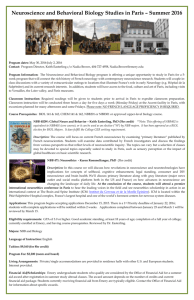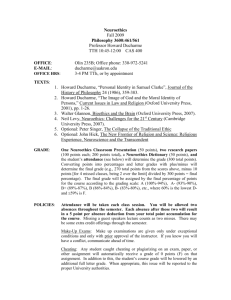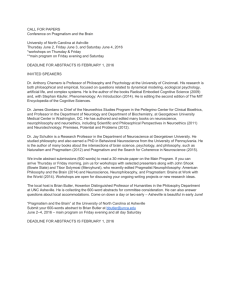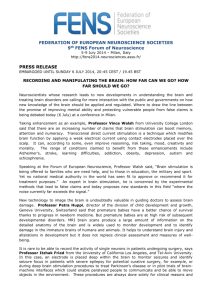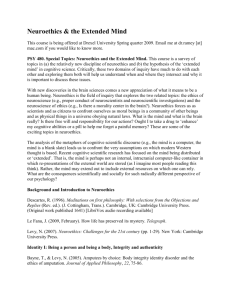Bioethics 505: Contemporary Issues in Neuroethics
advertisement
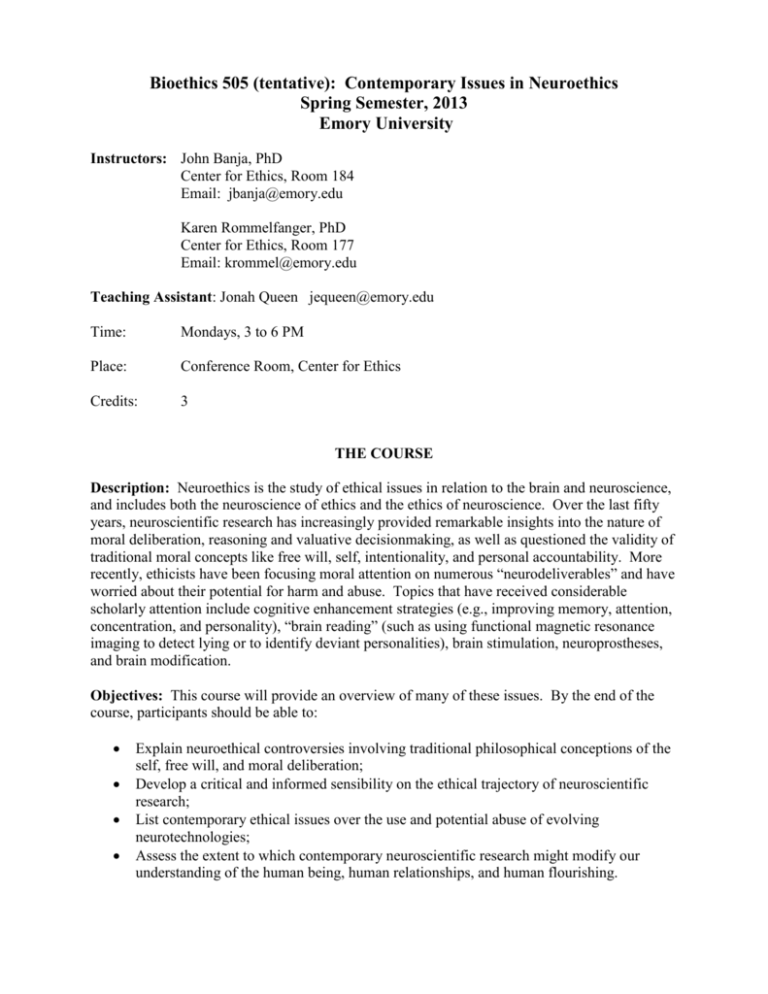
Bioethics 505 (tentative): Contemporary Issues in Neuroethics Spring Semester, 2013 Emory University Instructors: John Banja, PhD Center for Ethics, Room 184 Email: jbanja@emory.edu Karen Rommelfanger, PhD Center for Ethics, Room 177 Email: krommel@emory.edu Teaching Assistant: Jonah Queen jequeen@emory.edu Time: Mondays, 3 to 6 PM Place: Conference Room, Center for Ethics Credits: 3 THE COURSE Description: Neuroethics is the study of ethical issues in relation to the brain and neuroscience, and includes both the neuroscience of ethics and the ethics of neuroscience. Over the last fifty years, neuroscientific research has increasingly provided remarkable insights into the nature of moral deliberation, reasoning and valuative decisionmaking, as well as questioned the validity of traditional moral concepts like free will, self, intentionality, and personal accountability. More recently, ethicists have been focusing moral attention on numerous “neurodeliverables” and have worried about their potential for harm and abuse. Topics that have received considerable scholarly attention include cognitive enhancement strategies (e.g., improving memory, attention, concentration, and personality), “brain reading” (such as using functional magnetic resonance imaging to detect lying or to identify deviant personalities), brain stimulation, neuroprostheses, and brain modification. Objectives: This course will provide an overview of many of these issues. By the end of the course, participants should be able to: Explain neuroethical controversies involving traditional philosophical conceptions of the self, free will, and moral deliberation; Develop a critical and informed sensibility on the ethical trajectory of neuroscientific research; List contemporary ethical issues over the use and potential abuse of evolving neurotechnologies; Assess the extent to which contemporary neuroscientific research might modify our understanding of the human being, human relationships, and human flourishing. 2 Course Requirements: Attendance/Participation (50%): Course preparation, participation, and leadership (50 percent). Faculty and students will share responsibility for classes. Students will be expected to prepare for each class discussion through reading and, if they are designated to lead class that day, by planning and conducting discussions per the assigned readings (see below). Students will also create a brief summary handout/outline on their assigned readings to share with the class. Students will sign up to lead discussions on assigned readings on the following dates: Feb 4, Feb 18, Feb 25, March 4, March 18, April 1, and April 15 Blog Posts (10%): One blog post between ~500-1000 words per post. The tone can be more casual than a manuscript but should include references. The blogs should be written in a word document (We will copyedit and upload the text on the blog). Please do not submit pdfs. You can also refer to The Neuroethics Blog (www.theneuroethicsblog.com) and view links provided on the blog (to other blog posts) for more ideas. Students may choose to write about a topic related to the class he/she signs up to lead. The posts are due no later than April 14 at 5:00 PM, but we highly recommend you submit them earlier in the semester. Class presentation (10%): On either April 22 or April 29, each student will be responsible for giving a presentation on a topic of their choice, by choosing readings and leading a discussion on one of the topics listed below. Students will therefore determine the nature of the topics discussed in class during the latter half of the semester and present. Students may also choose to present on a topic directly related to their Final Paper. Final Paper (30%). Each student will prepare a 12 page (Double-spaced, 12pt font, approximately 2500 words), referenced paper on a neuroethics topic that is negotiated with the instructors. The topic should be selected and approved by instructors by March 4 (before Spring Break). The paper is due on May 3 by 5:00 PM. Students can choose from at least three approaches in writing a final paper. One is to write an overview of a particular topic. Just as various of the assigned readings have done, the idea is to summarize the most representative points of view on a particular issues—i.e., perform a fairly extensive literature review—and then end the paper with some comments on the future direction of the problem or the research that underpins. A second approach would be to write a critical paper the either favors or opposes a certain trend, direction, or research trajectory in neuroethics. This would essentially take an argumentative form, where the author would give persuasive reasons for his or her point of view. A third approach would be to write a paper on a largely if not thoroughly novel issue in neuroethics. This approach would bear heavily on the author’s creative imagination, of course, but that impulse must nevertheless be restrained by the topic’s reasonableness and relevance to contemporary neuroethics, and must be supported by relevant citations of the literature. Students may also take this opportunity to write their paper in the format of a “Target Article” for American Journal of Bioethics Neuroscience http://www.tandfonline.com/toc/uabn20/current) . Regardless of whatever approach the student uses, the instructors will expect work of a qualify befitting a graduate course at Emory University. Careless grammar, spelling, punctuation etc., is simply intolerable, while insufficient depth and clarity of reasoning and argumentation will likewise result in a low grade. 3 Grading Rubric/Assignments: Class Attendance and Participation: 50% Blog post on class topic: 10% Class presentation on topic of interest: 10% 12 page Final Paper due on April 29: 30% *Students are expected to attend every class and will be penalized for excessive absences. Students are expected to abide by Emory University’s Honor Code: http://college.emory.edu/home/academic/policy/honor_code.html Instructors reserve the right to revise syllabus throughout the semester. AGENDA/ASSIGNMENTS January 14: Introduction to the course Racine, E. Pragmatic Neuroethics Ch 1-2. 2010. Chapters 3-4 from Mind and Morals: Essays on Cognitive Science and Ethics, MIT Press, 1998 Suggested: Illes J, Bird SJ. Neuroethics: A modern context for ethics in neuroscience. Trends in Neuroscience, 2006; 29(9):511-517. Wolpe PR. Neuroethics. In S. Post, Ed., Encyclopedia of Bioethics, New York: Macmillan, 2004; 4:1894-98. January 28: Brain structure and function; Overview of neurotechnologies BRAIN STRUCTURE/FUNCTION (Guest speaker Dr. Gillian Hue) Brain Facts: A Primer on the Brain and the Nervous System (2012) Society for Neuroscience. Suggested: Understanding complexity in the human brain Danielle S. Bassett, Michael S. Gazzaniga Trends Cogn Sci. 2011 May; 15(5): 200–209. NEUROTECHNOLOGIES Soc Sci Med. 2010 Aug;71(4):725-33 Contemporary neuroscience in the media. Racine E, Waldman S, Rosenberg J, Illes J. Cognition. 2008 Apr;107(1):343-52. Seeing is believing: the effect of brain images on judgments of scientific reasoning. McCabe DP, Castel AD. Bioethics. 2006 Feb;20(1):37-52. Neuroethics. Glannon W. 4 Suggested: The neuroethics of non-invasive brain stimulation. Cohen Kadosh R, Levy N, O'Shea J, Shea N, Savulescu J. Curr Biol. 2012 Feb 21;22(4):R108-11 Rabins P, et al. Scientific and ethical issues related to deep brain stimulation for disorders of mood, behavior and thought. Archives of General Psychiatry, 2009; 66(9):931-937. Deep Brain Stimulation for Depression CNN Presents Special with Dr. Sanjay Gupta: http://youtu.be/Lq5rIILcVgA February 4: Selfhood and Free Will Part I Libet B. Do we have free will? Journal of Consciousness Studies, 1999; 6(8-9):47-57. Wegner DM. Precis of The Illusion of Conscious Will. Behavioral and Brain Sciences, 2004; 27:649-659. How does the neuroscience of decision making bear on our understanding of moral responsibility and free will? Roskies AL. Curr Opin Neurobiol. 2012 Dec;22(6):1022-6. Kerri Smith Neuroscience v. Philosophy: Taking Aim at Free Will 31 August 2011 | Nature 477, 23-25 (2011) Conscious Cogn. 2011 Mar;20(1):64-74. Through the looking glass: self and others. Sinigaglia C, Rizzolatti G. Science. 2009 May 8;324(5928):811-3. Movement intention after parietal cortex stimulation in humans. Desmurget M, Reilly KT, Richard N, Szathmari A, Mottolese C, Sirigu A. Suggested: Churchland PS. Brain Wise. Cambridge, MA: MIT Press, 2002. Chapter 3. Damasio A. The Feeling of What Happens. New York, NY: Harcourt Brace, 1999. Chapter 5. February 11: Selfhood and Free Will Part II 5 Guest Speakers: Julia Haas (300-430): Akrasia—weakness of will; Dr. Eddy Nahmias (430-6): Behavioral responses to free will statements From Dr. Nahmias Is Free Will an Illusion? Confronting Challenges from the Modern Mind Sciences for Moral Psychology, vol. 4: Freedom and Responsibility, edited by Walter Sinnott-Armstrong From Julia Haas "Moral Motivation," by Timothy Schroeder, Adina L. Roskies, and Shaun Nichols, in Doris (ed.) The Moral Psychological Handbook, 72-110. 'Weakness of Will,' by Sarah Stroud, from the Stanford Encyclopedia of Philosophy, available at http://plato.stanford.edu/entries/weakness-will/. February 18: Moral Reasoning Bloom P. The moral life of babies. The New York Times, May 3, 2010. Banja J. 2011. Virtue essentialism, prototypes, and the moral conservative opposition to enhancement technologies: A neuroethical critique. AJOB Neuroscience. 2(2):31-38. Greene J. From neural ‘is’ to moral ‘ought’: What are the moral implications of neuroscientific moral psychology? Nature Reviews Neuroscience, 2003; 4:847-850. Haidt J. The emotional dog and its rational tail: A social intuitionist approach to moral judgment. Psychological Review, 2001; 108:814-834. Pinker S. The moral instinct. The New York Times, Jan. 13, 2008. Practical implications of empirically studying moral decision-making. Heinzelmann N, Ugazio G, Tobler PN.Front Neurosci. 2012;6:94 Suggested: Clark A. Connectionism, moral cognition, and collaborate problem solving. In L. May, M. Friedman, A. Clark, (Eds.), Mind and Morals. Cambridge, MA: MIT Press, 1998; 109-127. Greene J, Haidt J. How (and where) does moral judgment work? Trends in Cognitive Sciences, 2002; 6(12):517-523. Kunda Z. The case for motivated reasoning. Psychological Bulletin, 1990; 108:480-498. Miller G. The roots of morality. Science, 2008; 320:734-737. Westen D, Blagov,P. A clinical-empirical model of emotion regulation: From defenses and motivated reasoning to emotional constrain satisfaction. In J. Gross (Ed.), Handbook of Emotional Regulation. New York, NY: Guilford press. 6 February 25: Neurolaw (Guest Speaker Professor Julie Seaman) EVIDENCE/ADMISSIBILITY Seaman, J. (2009). Black boxes: fMRI lie detection and the role of the jury. Akron L. Rev., 42, 931. Jones, O., Buckholtz, J., Schall, J., & Marois, R. (2009). Brain imaging for legal thinkers: a guide for the perplexed. Stanford Technology Law Review, 5, 10-09. Moriarty, J. C. (2008). Flickering admissibility: neuroimaging evidence in the U.S. courts. Behav Sci Law, 26(1), 29-49. doi: 10.1002/bsl.795 CULPABILITY Morse, S.J. (2005). Brain overclaim syndrome and criminal responsibility: a diagnostic note. Ohio St. J. Crim. L., 3, 397. Snead, O.C. (2007). NEUROIMAGING AND THE" COMPLEXITY" OF CAPITAL PUNISHMENT. NYUL Rev., 82, 1265-1895. The Purpose in Chronic Addiction Hanna Pickard AJOB Neuroscience pages 40-49 The Neurobiology of Addiction: Implications for Voluntary Control of Behaviour (2011), Steven E. Hyman In Oxford Handbook of Neuroethics Suggested: Vetter A, Klaming L. Human enhancement for the common good—Using neurotechnologies to improve eyewitness memory. AJOB Neuroscience, 2010; 1(3):2233. See also the peer commentaries that follow this article on 34-50. Wolpe PR, Foster KR, Langleben DD. Emerging neurotechnologies for lie-detection: Promise and perils. AJOB, 2005; 5(2):39-49. See also the peer commentaries that follow on pages 50 to 63, and the commentary by Steve Hyman “Five Years Later” in AJOB, 2010; 10(10): 49-50. Cashmore AR. The lucretian swerve: The biological basis of human behavior and the criminal justice system. PNAS, 2010; 107(10):4499-4504. Rosen J. The brain on the stand. The New York Times Magazine. March 11, 2007. March 4: Enhancement I (Opponents/Proponents and Pharmacology) Chatterjee A. Cosmetic neurology: The controversy over enhancing movement, mentation, and mood. Neurology, 2004; 63:968-974. Greely H, Sahakian B, Harris J et al. Towards responsible use of cognitive-enhancing drugs by the healthy. Nature Advance Online Publication doi:10.1038/456702a, published online 7 December 2008. 7 Farah MJ, et al. Neurocognitive enhancement: What can we do and what should we do? Nature Reviews Neuroscience, 2004; 5:421-425. The President’s Council on Bioethics. Beyond therapy: Biotechnology and the pursuit of happiness. At http://www.bioethics.gov/reports/beyond therapy/chapter5.html. Chapter 5, pg 13-17 The Perils of Cognitive Enhancement and the Urgent Imperative to Enhance the Moral Character of Humanity by: Ingmar Persson, Julian Savulescu Journal of Applied Philosophy, Vol. 25, No. 3. (August 2008), pp. 162-177 Just how cognitive is ‘cognitive enhancement’? The significance of emotions in in university students’ experiences with study drugs by Scott Vrecko AJOB Neuroscience 4:1, 2013. Suggested: Neuroethics and the Possible Types of Moral Enhancement John R. Shook AJOB Neuroscience (2012 3:4), pages 3-14 Sandel MJ. The case against perfection. The Atlantic Monthly, April 2004, pages 51-62. Deflating the Neuroenhancement Bubble, Jayne C. Lucke, Stephanie Bell, Brad Partridge & Wayne D. Hall AJOB Neuroscience pages 38-43. Talbot M. Brain gain. The New Yorker, April 27, 2009, pages 32-43. Kass LR. Ageless bodies, happy souls. The New Atlantis. Spring 2003, pp. 9-28. March 11: No Class, Spring Break March 18: Enhancement II (Guest Speaker, Dr. Steve Potter BMI/Cyborgology) From Dr. Potter Spatio-temporal electrical stimuli shape behavior of an embodied cortical network in a goaldirected learning task. J. Neural Eng. 5 (2008) 310-23. The Neurally Controlled Animat: Biological Brains Acting with Simulated Bodies THOMAS B. DeMARSE, DANIEL A. WAGENAAR, AXEL W. BLAU, STEVE M. POTTER Published in final edited form as: Auton Robots. 2001; 11(3): 305–310. Additional Required Readings J Med Ethics. 2006 Feb;32(2):79-83. Cyborgs and moral identity. Gillett G. Brain to Computer Communication: Ethical Perspectives on Interaction Models Guglielmo Tamburrini in Neuroethics (2009) Brain-computer interfaces in medicine. Shih JJ, Krusienski DJ, Wolpaw JR. Mayo Clin Proc. 2012 Mar;87(3):268-79 8 Ethical issues in brain-computer interface research, development, and dissemination. Vlek RJ, et al J Neurol Phys Ther. 2012 Jun;36(2):94-9. Suggested: Robot Rights Shesen Guo and Ganzhou Zhang Science 13 February 2009: 876. March 25: Transhumanism and Personhood (Guest Speaker Dr. Cory Labrecque) Transhumanism Philosophy, Declaration, and FAQ at http://humanityplus.org/ Am J Bioeth. 2007 Jan;7(1):37-48. Personhood and neuroscience: naturalizing or nihilating? Farah MJ, Heberlein AS. Suggested: In defense of posthuman dignity. Bostrom N. Bioethics. 2005 Jun;19(3):202-14. “Future of Humanity,” http://www.nickbostrom.com/papers/future.html “Future of Human Evolution”: http://www.nickbostrom.com/fut/evolution.html April 1: Disorders of Consciousness Annu Rev Clin Psychol. 2012;8:431-54. Cognition in the vegetative state. Monti MM. Brain damage and the moral significance of consciousness. Kahane G, Savulescu J. J Med Philos. 2009 Feb;34(1):6-26 Sexuality and a Severely Brain-Injured Spouse. The Hastings Center Report May/June 2010 Functional neuroimaging of the vegetative state Nature Reviews Neuroscience 2008 BBC News - Vegetative patient Scott Routley says 'I'm not in pain' http://www.bbc.co.uk/news/health-20268044 A Drug That Wake the Near Dead – The New York Times http://www.nytimes.com/2011/12/04/magazine/can-ambien-wake-minimallyconscious.html?pagewanted=all Suggested: 9 Am J Bioeth. 2008 Sep;8(9):3-12. Neuroimaging and disorders of consciousness: envisioning an ethical research agenda. Fins JJ, Illes J, Bernat JL, Hirsch J, Laureys S, Murphy E. Annu Rev Psychol. 2013 64: 109-33 Detecting Consciousness: A Unique Role for Neuroimaging. Owen AM. Deep brain stimulation, neuroethics, and the minimally conscious state: moving beyond proof of principle. Schiff ND, Giacino JT, Fins JJ. Arch Neurol. 2009 Jun;66(6):697-702. April 8: Neurotheology and Neuroscience of Belief (Guest Speaker Dr. Cory Labrecque) Wolpe PR Religious responses to neuroscientific questions CH 20 in Neuroethics: Defining the issues in theory, practice, and policy (Illes eds) Cogn Process. 2009 Nov;10(4):293-326. Is our brain hardwired to produce God, or is our brain hardwired to perceive God? A systematic review on the role of the brain in mediating religious experience. Fingelkurts AA, Fingelkurts AA. Scientific American Mind (October/November 2007), 18, 38-45 Searching for God in the Brain David Biello Suggested: Compassion, ethics, and neuroscience: neuroethics through buddhist eyes. Tsomo KL. Sci Eng Ethics. 2012 Sep;18(3):529-37. The spirituality of human consciousness: a catholic evaluation of some current neuroscientific interpretations. McGoldrick TA. Sci Eng Ethics. 2012 Sep;18(3):483-501 Ethical concepts and future challenges of neuroimaging: an islamic perspective. Al-Delaimy WK. Sci Eng Ethics. 2012 Sep;18(3):509-18. Newberg, D’Aquili, and Rause’s Why God Won’t Go Away: Brain Science and the Biology of Belief April 15: Neurodiversity (Guest speaker, Jennifer Sarrett) Autism as a natural human variation: reflections on the claims of the neurodiversity movement. Jaarsma P, Welin S. Health Care Anal. 2012 Mar;20(1):20-30. Quirky Citizens: Autism, Gender, and Reimagining Disability. By: Bumiller, Kristin. Signs: Journal of Women in Culture & Society, Summer 2008, Vol. 33 Issue 4, p967-991, 25p Video: “In My Language” 2007 http://youtu.be/JnylM1hI2jc ‘Mad Pride’ Fights a Stigma NYT 2008 10 http://www.nytimes.com/2008/05/11/fashion/11madpride.html?pagewanted=all&_r=0 Hastings Cent Rep. 2009 Jul-Aug;39(4):49. Mad pride and the medical model. Jost A. April 22: Student Presentations April 29: Student Presentations STUDENT PRESENTATIONS Each student will find and provide readings to the class from the following list of topics, and then will be responsible for presenting the topic in class and leading discussion on April 22 or April 29. Students are not limited to these topics and can write on topics approved by instructors. Choose from the following list: Animals Brain Imaging Children, Treatment Children, Enhancement Children, Aptitude/tracking Chimeras and Neural Cell Implants Clinical Issues Consciousness and Selfhood Cyborgology Deafness, Definitions of Illness Deep Brain Stimulation Enhancement Ethics of Brain Research Forensic, Criminal Issues Genes and Brains Government Research Lie Detection and Legal Issues Memory erasing/enhancement Mind Reading Mind Manipulation Neuroethics (General) Neuroscience of Ethics Neuroscientific reductionism Neurotheology Policy Prediction, Prognosis Psychiatry, Mental Illness Psychopharmacology

